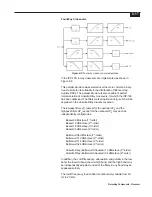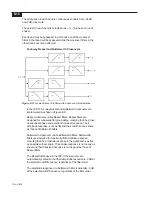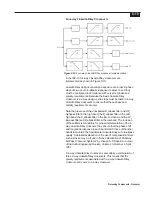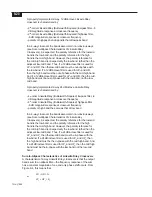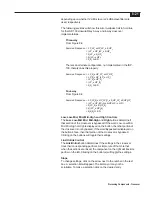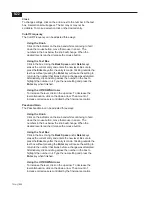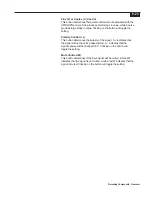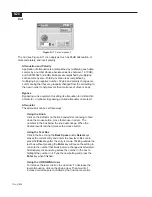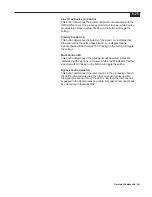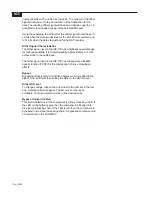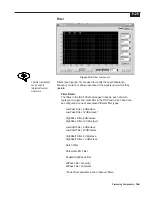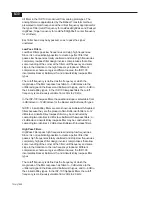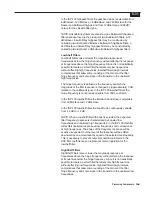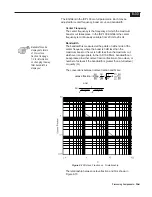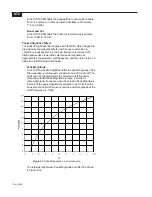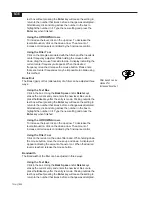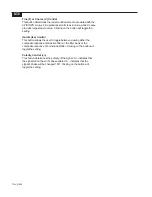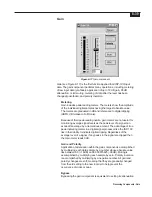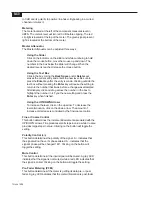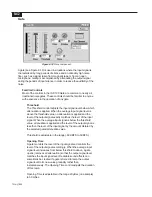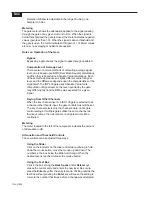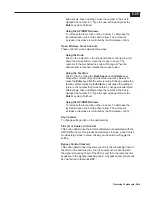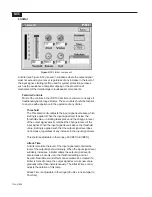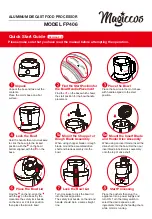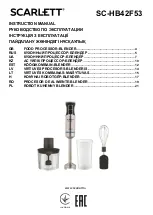
8-31
Processing Components - Filter
In the ISP-100 highpass filters the passband slope is selectable from
6 dB/octave, 12 dB/octave, 18 dB/octave, and 24 dB/octave for the
Bessel and Butterworth types, and from 12 dB/octave and 24 dB/
octave for the Linkwitz-Riley type.
NOTE: Linkwitz-Riley filters are also known as Butterworth-Squared
filters because they are the product of two Butterworth filters. A 12
dB/octave Linkwitz-Riley highpass filter may be constructed by
cascading two identical 6 dB/octave Butterworth highpass filters; a
24 dB/octave Linkwitz-Riley highpass filter may be constructed by
cascading two identical 12 dB/octave Butterworth highpass filters.
LowShelf Filters
LowShelf Filters raise or lower the magnitude response at
frequencies below the hinge frequency without altering the response
at frequencies above the hinge frequency. Since it is not realistically
possible to create a perfect filter that alters only low frequencies
without affecting high frequencies, lowshelf filter design involves
compromises that allow some rounding of the corner at the filter
hinge frequency and some slope in the transition to the unaltered
high frequencies.
The hinge frequency is defined as the frequency at which the
magnitude of the filter response is changed by (approximately) 3 dB
relative to the unfiltered signal. In the ISP-100 lowshelf filters the
hinge frequency is continuously variable from 20Hz to 20 kHz.
In the ISP-100 lowshelf filters the transition band slope is selectable
from 6 dB/octave and 12 dB/octave.
In the ISP-100 lowshelf filters the boost/cut is continuously variable
from -12 dB to +12 dB.
NOTE: When a lowshelf filter with boost is selected, the expected
filter frequency response is characterized by boosted low
frequencies and unaltered high frequencies. In the ISP-100 this filter
will exhibit unaltered response at low frequencies and cut response
at high frequencies. The shape of the frequency response will be
exactly as expected, but the level of the response will be shifted
downward by an amount exactly equal to the selected boost quantity.
This is necessary to prevent numerical overflow problems in the
DSP filter coefficients, and represents normal operation for the
lowshelf filter.
HighShelf Filters
HighShelf Filters raise or lower the magnitude response at
frequencies above the hinge frequency without altering the response
at frequencies below the hinge frequency. Since it is not realistically
possible to create a perfect filter that alters only high frequencies
without affecting low frequencies, highshelf filter design involves
compromises that allow some rounding of the corner at the filter
hinge frequency and some slope in the transition to the unaltered low
frequencies.
Summary of Contents for Integrated Signal Processor ISP-100
Page 1: ...User s Manual ISP 100 INTEGRATED SIGNAL PROCESSOR...
Page 2: ...THIS PAGE LEFT BLANK INTENTIONALLY...
Page 24: ...2 10 10 July 1998 THIS PAGE LEFT BLANK INTENTIONALLY...
Page 32: ...3 8 10 July 1998 THIS PAGE LEFT BLANK INTENTIONALLY...
Page 48: ...5 6 10 July 1998 THIS PAGE LEFT BLANK INTENTIONALLY...
Page 126: ...A 4 10 July 1998 THIS PAGE LEFT BLANK INTENTIONALLY...
Page 128: ...B 2 10 July 1998 MONDOEQ QMS...
Page 129: ...B 3 Standard QuickMAPs 2X6CMBC QMS...
Page 130: ...B 4 10 July 1998 2X8COMB QMS...
Page 131: ...B 5 Standard QuickMAPs 3X6CMBC QMS...
Page 132: ...B 6 10 July 1998 2X8THRU QMS...
Page 133: ...B 7 Standard QuickMAPs 4CHAN QMS...
Page 134: ...B 8 10 July 1998 4X6CMBC QMS...
Page 135: ...B 9 Standard QuickMAPs 4X6THRU QMS...
Page 136: ...B 10 10 July 1998 3_2W QMS...
Page 137: ...B 11 Standard QuickMAPs 2WAYS QMS...
Page 138: ...B 12 10 July 1998 2_3WAY QMS...
Page 139: ...B 13 Standard QuickMAPs 2_2W_SUB QMS...
Page 140: ...B 14 10 July 1998 2_2W_FR QMS...
Page 141: ...B 15 Standard QuickMAPs 2_2W_2ST QMS...
Page 142: ...B 16 10 July 1998 4_2WAYS QMS...
Page 143: ...B 17 Standard QuickMAPs 4W_2FR QMS...
Page 144: ...B 18 10 July 1998 LCR QMS...
Page 145: ...B 19 Standard QuickMAPs MONO3W QMS...

